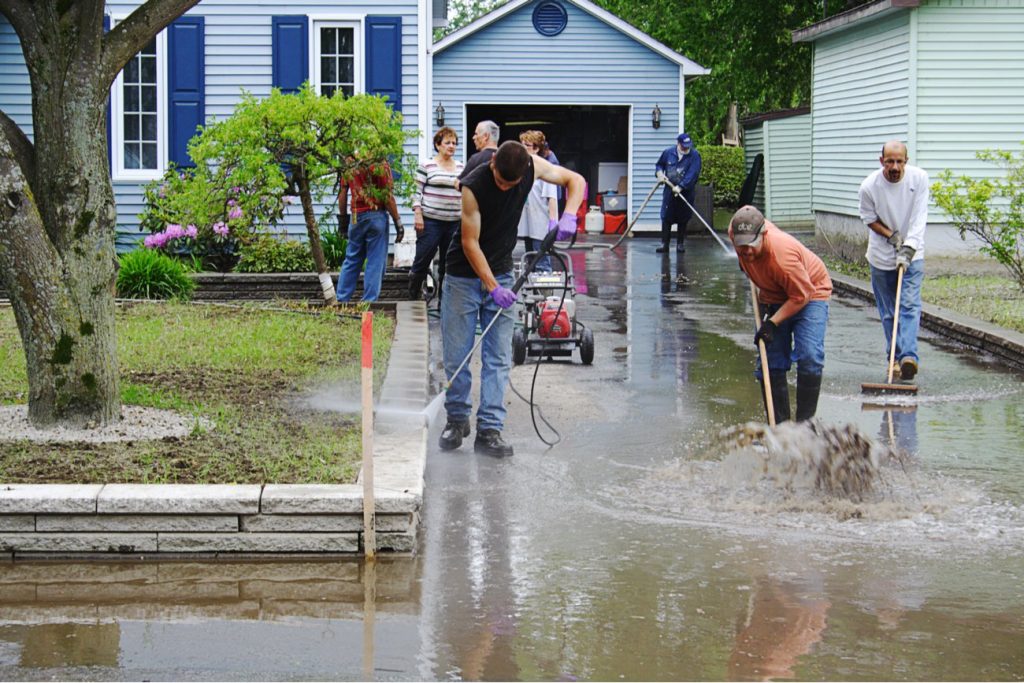Dealing with water, fire, or flood damage can be overwhelming, especially during an emergency. Understanding how to respond effectively can minimize the damage and help restore your property as quickly as possible. This guide provides essential steps to take in each scenario, tips for safety, and advice on working with professionals for recovery.
Water Damage: Immediate Response
Water damage can stem from various sources, such as burst pipes, leaky roofs, or severe weather. When you encounter water damage, taking immediate action is crucial.
1. Ensure Safety First
Before addressing the water damage, prioritize safety:
- Turn Off Electricity: If the water is near electrical outlets, turn off the power at the main breaker to avoid electric shock.
- Wear Protective Gear: Use gloves and boots to protect yourself from contaminants in the water.
- Assess for Structural Damage: Check for sagging ceilings or walls that may collapse. If you see significant damage, evacuate the premises.
2. Stop the Source of Water
If possible, identify and stop the source of the water. This may involve shutting off the main water valve, repairing a broken pipe, or using a wet-dry vacuum to remove standing water.
3. Remove Excess Water
Use buckets, mops, or a wet-dry vacuum to remove as much water as possible. If the damage is extensive, consider renting a commercial-grade water extraction machine.
4. Dry the Area
Once the water is removed, dry the area as quickly as possible:
- Open Windows: Increase airflow by opening windows and doors.
- Use Fans and Dehumidifiers: Position fans to circulate air and place dehumidifiers to draw out moisture.
- Remove Carpets and Rugs: Take wet carpets and rugs outside to dry. If they’re saturated, consider discarding them.
5. Call Professionals
After managing the initial damage, contact a water damage restoration company. These experts have specialized equipment and techniques to ensure proper drying, sanitation, and restoration. They can also assist with any necessary repairs.
Fire Damage: Immediate Response
Experiencing a fire can be devastating. The first priority should always be the safety of individuals involved.
1. Evacuate Immediately
If there is a fire, evacuate the premises without delay. Follow your escape plan, and ensure everyone is accounted for.
2. Call Emergency Services
Once you are safe, call 911 or your local emergency number to report the fire. Provide clear information about the location and extent of the fire.
3. Avoid Re-Entry
Do not attempt to return to the building until it has been declared safe by fire officials. Re-entering a structure before it is deemed safe can put your life at risk.
4. Document the Damage
If safe to do so, take photos or videos of the damage for insurance purposes. This documentation will be crucial when filing claims.
5. Contact Your Insurance Provider
Notify your insurance company about the fire damage. They will guide you through the claims process and advise on next steps.
6. Hire Fire Damage Restoration Professionals
Fire damage restoration involves more than just cleaning up. Professionals will address soot and smoke damage, perform structural assessments, and handle any necessary repairs. They can also help mitigate issues related to water damage from firefighting efforts.
Flood Damage: Immediate Response
Flooding can result from natural disasters, heavy rainfall, or other emergencies. Responding quickly can help reduce damage and ensure safety.
1. Prioritize Safety
Similar to other emergencies, safety is paramount. Follow these guidelines:
- Avoid Floodwaters: Stay away from floodwaters, as they can be contaminated and pose health risks.
- Check for Structural Damage: If you’re in a flooded building, assess for any structural damage before attempting to leave.
2. Evacuate if Necessary
If flooding poses a threat to your safety, evacuate the area immediately. Follow local authorities’ evacuation orders and use designated routes.
3. Turn Off Utilities
If it is safe to do so, turn off the electricity, gas, and water supplies to prevent further damage and hazards.
4. Document Damage
If you have the opportunity, take pictures of the flood damage for your records and insurance claims. This documentation can be crucial for financial recovery.
5. Contact Emergency Services
For severe flooding situations, contact local emergency services or your community’s disaster response team for assistance.
6. Call Flood Damage Restoration Experts
Flood damage restoration requires specialized equipment and techniques. Contact professionals who are trained to handle flood recovery. They will assess the damage, remove standing water, and dry the area effectively.
General Tips for All Emergencies
1. Create an Emergency Plan
Having an emergency plan in place can significantly reduce chaos during a disaster. Include evacuation routes, emergency contacts, and important documents in a safe, easily accessible location.
2. Assemble an Emergency Kit
Prepare an emergency kit that includes:
- First aid supplies
- Flashlights and batteries
- Non-perishable food and water
- Important documents (insurance policies, identification)
- Clothing and personal hygiene items
3. Stay Informed
Monitor local news and weather updates to stay informed about potential emergencies in your area. Having real-time information can help you react appropriately.
4. Regular Maintenance
Conduct regular maintenance on your property to minimize risks:
- Inspect your roof for leaks.
- Clean gutters and downspouts to prevent water buildup.
- Check electrical systems and wiring.
5. Review Insurance Policies
Ensure your insurance policies cover water, fire, and flood damage. Understand your coverage limits and deductibles, and update your policies as necessary.
Conclusion
Handling water, fire, and flood damage during an emergency requires prompt action and careful planning. Prioritizing safety, stopping the source of damage, documenting the situation, and contacting professionals are critical steps to mitigate loss. By preparing an emergency plan, assembling a kit, and conducting regular maintenance, you can better equip yourself to face any emergency situation. When disasters strike, a proactive approach can make all the difference in protecting your property and ensuring the safety of those you love.

